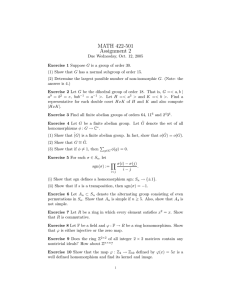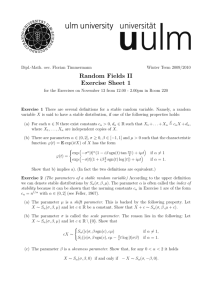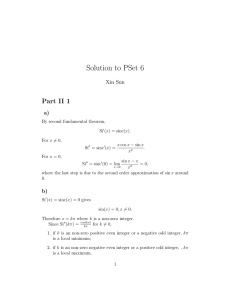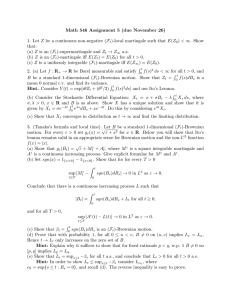( )
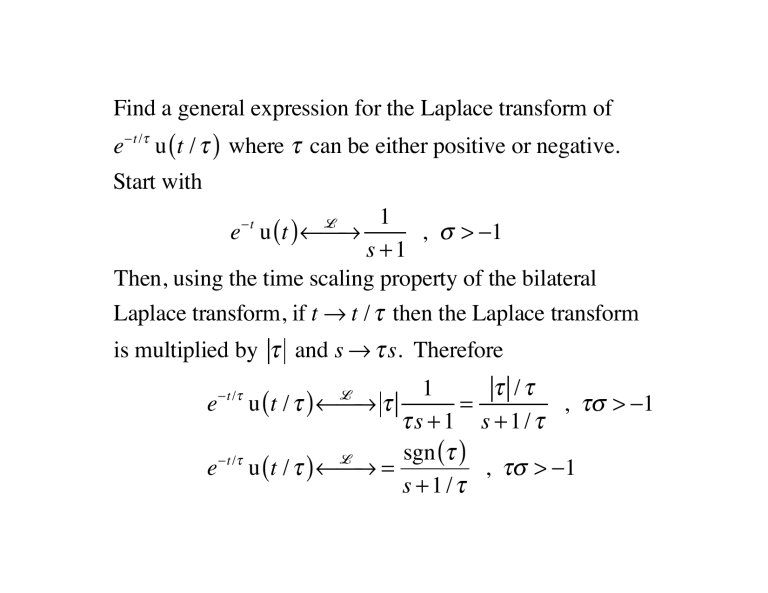
Find a general expression for the Laplace transform of e
− t /
τ u
( )
where
τ
can be either positive or negative.
Start with e
− t u
( )
L
1 s
+
1
,
σ > −
1
Then, using the time scaling property of the bilateral
Laplace transform, if t
→ t /
τ
then the Laplace transform is multiplied by
τ
and s
→ τ s . Therefore e
− t /
τ e
− t /
τ u
( )
L τ u
( )
L =
1
τ s
+
1 sgn
( ) s
+
1 /
τ
=
τ
/
τ s
+
1 /
τ
,
τσ > −
1
,
τσ > −
1
e
− t /
τ u
( ) ← →
Notice that if
= sgn
( ) s
+
1 /
τ
τ
,
τσ > −
1
τ >
0, then
τσ > −
1 and the ROC is
σ > −
1 /
τ <
0, to the right of the pole at s
= −
1 /
τ
. If
τ <
0 then
τσ > −
1and the ROC is
σ < −
1 /
τ =
1 /
τ >
0, to the left of the pole at s
= −
1 /
τ
.
Now, find a general expression for e
− t /
τ
1 u
( t /
τ
1
)
∗ e
− t /
τ
2 u
( t /
τ
2
) where
τ
1
and
τ
2
can both be either positive or negative.
Using the previous result, and the Multiplication-Convolution duality property of the bilateral Laplace transform, e
− t /
τ
1 u
( t /
τ
1
)
∗ e
− t /
τ
2 u
( t /
τ
2
)
L sgn
( ) s
+
1 /
τ
1
1 sgn
( ) s
+
1 /
τ
2
,
τ
1
σ > −
1
∩ τ
2
σ > −
1
e
− t /
τ u
( t /
τ
1
)
∗ e
− t /
τ
2 u
( t /
τ
2
)
L sgn
( ) s
+
1 /
τ
1 sgn
( ) s
+
1 /
τ
2
2
,
τ
1
σ > −
1
∩ τ
2
σ > −
1
Case 1:
τ e
− t /
τ
1 u
( t /
1
τ
1
≠
)
τ
∗
2 e
− t /
τ
2 u
( t /
τ
2
) e
− t /
τ
1
If
τ
1
⎯ sgn u
( t /
τ
1
) sgn
∗
( ) e
−
( ) t
τ
/ sgn
τ
1
2 sgn
− u
τ
( t
( )
2
τ
/
τ
⎜
⎝
⎜
⎜
⎛
τ
2
)
−
1 /
τ
1
+ s
+
1 /
1 /
τ
1
1
τ
2
⎝⎜
⎛
1
1 s
+
1 /
τ
τ
1
2
−
+
1
−
1 /
τ
2
+ s
+
1 /
1 /
τ
2
1 s
+
1 /
τ
2
⎠⎟
⎞
τ
1
⎟
⎠
⎟
⎟
⎞
,
τ
1
σ > −
1
∩ τ
2
σ > −
1
,
τ
1
σ > −
1
∩ τ
2
σ > −
1
>
0 and
τ
2
>
0, then e
− t /
τ
1 u
( t /
τ
1
)
∗ e
− t /
τ
2 u
( t /
τ
2
)
L e
− t /
τ
1
τ
1
−
τ ⎛
1
τ
1
2
τ
2
⎝⎜ u
( t /
τ
1
)
∗ e
− t /
τ
2 u
( t /
τ
2
)
= s
+
1 /
τ
1
τ
2
(
τ
1 e
−
− t /
τ
1
τ
1
1 s
+
1 /
τ
− e
− t /
τ
− τ
2
2
2
⎞
,
σ > −
1 /
τ
⎠⎟
) u t
1
∩ σ > −
1 /
τ
2
e
− t /
τ
1 u
( t /
τ
1
)
∗ e
− t /
τ
2 u
( t /
τ
2
)
L sgn
( ) s
+
1 /
τ
1 sgn
( ) s
+
1 /
τ
2
2
,
τ
1
σ > −
1
∩ τ
2
σ > −
1
If
τ
1
>
0 and
τ
2
<
0, then e
− t /
τ
1 u
( t /
τ
1 e
− t /
τ
1
)
∗ e
− t /
τ
2 u
( t /
τ
2
)
L
τ
1
τ
1
−
τ
2
τ
2 u
( t /
τ
1
)
∗ e
− t /
τ
2 u
( t /
τ
2
)
= −
τ
1
τ
2
⎝⎜
⎛
1 s
+
1 /
⎡⎣ e
− t /
τ
1
τ
1
−
1 s
+
1 /
τ
2
⎠⎟
⎞
,
σ > −
1 /
τ
1 u
( ) + e
− t /
τ
2 u
( ) ⎤⎦
τ
1
− τ
2
Generalizing, if
τ
1
≠ τ
2 e
− t /
τ u
( t /
τ
1
)
∗ e
− t /
τ
2 u
( t /
τ
2
)
=
τ
1
τ
1
τ
−
2
τ
2
⎡⎣ sgn
∩ σ < −
1 /
τ
2
( ) e
− t /
τ
1 u
( t /
τ
1
)
− sgn
τ e
− t /
τ
2 u
( t /
τ
2
) ⎤⎦
Case 2:
τ
1
= τ
2
= τ e
− t /
τ u
( ) ∗ e
− t /
τ u
( )
L
⎡
⎣⎢ sgn
( ) s
+
1 /
τ ⎦⎥
⎤ 2
,
τσ > −
1 e
− t /
τ e
− t /
τ u u
( )
( )
∗
∗ e e
−
− t t
/
/
τ
τ u u t t
/
/
τ
τ
L
( )
= sgn
τ
(
( ) te
−
1 s
+
1 / t /
τ
τ u
)
2 t
,
τσ > −
1
( )
= t e
− t /
τ u t /
τ
Convolve tri tri
( n / N
) ∗ u
( n
[ ]
/ N
=
(
)
with u ramp
[ n
[ ]
+
N
and express the result without using the "
] −
2 ramp n
+ ramp
[ n
−
N
] )
∗ u n
∗
" operator.
ramp
[ ] ∗ u
[ ]
Z
Using n 2 u
[ ]
Z
( z z
−
1
)
2
( +
1
)
( z
−
1
)
3
,
× z z
−
1
=
2
( z z
−
1
)
3
, z
>
1
ramp ramp
[ ] ∗ δ
[ ] n
∗
+ u
[ n
2 u
[
− n
1
]
−
1
]
Z
( z z
−
1
)
3 ramp
[ ] ∗ u n
+ ramp n
∗ u
[ n
−
1
]
Z
(
( )
)
= n
=
2 n u
2 u n n
, z
>
1 ramp
[ ] ∗ u n
+ u
[ n
−
1
] [ ]
and
From a graph it is easy to show that u
[ ]
[ ] +
2
( z z
−
1
)
3 u
[ n
−
1
]
+
=
( z z
−
1
)
3
δ n
+
=
2 u
( +
1
)
( z
−
1
)
3
[ n
−
1
]
, z
>
1
. Therefore ramp
[ ] ∗ u
[ n
−
1
] = n 2 u
[ ] − ramp
[ ]
2
⇒ ramp
[ ] ∗ u
[ ] =
( n
+
1
)
2 u
[ n
+
1
] − ramp
[ n
+
1
]
2
Two sinusoids are described by
x
1
( ) =
( π f
1 t
Both are sampled at a rate f
) s
and x
2
( ) = cos 2
π f
to form x
1
(
[ ]
and x
2
2 t
)
.
[ ]
. What values of f s
make x
1
[ ] = x
For equality cos 2 cos 2
2
π
( f
1
π f
1 n / f s
+ Δ f
) n /
) f
= s
π
(
2 f
1
[ ]
?
n / f
π
( f s
1
−
2
π f
1 n / f
)
= cos 2
π f s
+ Δ f
) n / f s
)
2 n / f s
)
. Let f
2
= f
1
=
An integer multiple of 2
π
+ Δ f . Then
2
πΔ fn / f s
Δ fn / f s
=
An integer multiple of 2
=
An integer
π
Since n is already an integer, and the product of any two integers is an integer,
Δ f / f s
must be an integer. In other words,
Δ f must be an integer multiple of f s
.
If 2 e
− t /
τ ⎡⎣ ( ) + ( ) ⎤⎦ u
( )
L s 2
2 s
+
A
+ s
+
16.25
find
τ
and A .
2 e
− t /
τ ⎡⎣
( )
+
( )
⎤⎦ u
( )
L
2 ⎢
⎡
⎣
( s
+
1 / s
+
1 /
τ
τ
)
2 +
16
+
0.4
( s
+
1 /
τ
4
)
2 +
B 2
2 ⎢
⎡
⎣
( s
+
1 / s
+
1 /
τ
τ
)
2 +
16
+
0.4
( s
+
1 /
τ
4
)
2 +
16
⎤
⎦
⎥ = s 2
2 /
τ =
1
⇒ τ =
2 , 1 /
τ 2 +
16
=
16.25 Check
2 /
τ +
3.2
=
A
⇒
A
=
3.2
+
1
=
4.2
2 s
+
2 /
+
2 s /
τ +
3.2
τ +
1 /
τ 2 +
16
= s 2
2 s
+
A
+ s
+
16.25
⎥
⎤
⎦
What is the quickest way to determine whether a signal is bandlimited?
1. If it is time limited it is not bandlimited.
2. If it contains impulses it is not bandlimited.
sinc
( ) δ
10
( )
contains impulses and is not bandlimited
sinc
( ) ∗ δ
10
( )
DOES NOT contain impulses, sinc t
∗ δ
10
( ) =
∞
∑
k
= −∞ sinc
( t
−
10 k
)
sinc
( ) ∗ δ
10
( )
is bandlimited
3. If the signal contains any discontinuities or any derivatives with discontinuities
the signal is not bandlimited.
rect
( ) ∗ δ
8
( )
has discontinuities and tri
( ) ∗ δ
22
( )
has a discontinuous first derivative
Both are not bandlimited
rect
( ) ∗ δ
1
( )
and tri t
∗ δ
1
( )
do not have any discontinuities or any
derivatives with discontinuities and ARE BANDLIMITED
4. In any case you can always look at the magnitude of the CTFT to see whether
it goes to zero at a finite frequency AND STAYS THERE. If that happens, the
the signal is bandlimited.
ω
10
5
0
-5
-10
-4 -2 0 2
[ s ]
1
σ
0
2
-1
4
[ z ]
-1 0 1 2
ω
10
5
0
-5
-10
-4 -2 0 2
[ s ]
σ
2
1
0
-1
4
[ z ]
-1 0 1 2 z
= e sT s , T s
=
0.5
ω
0
-5
-10
-4
10
5
-2 0 2
[ s ]
σ
2
1
0
-1
4
[ z ]
-1 0 1 2
ω
10
5
0
-5
-10
-4 -2 0 2
[ s ]
σ
2
1
0
-1
4
[ z ]
-1 0 1 2
What would be the best description of these filters, lowpass, highpass, bandpass or bandstop (even if the description is not exact)?
H
( ) = z 2 z 2 −
1
+
0.81
⇒
Zeros at
Ω =
0 and
π
, poles at z
= ± j 0.9.
⇒
Zero response at very low and very high frequencies. Large response
at
Ω = ± π
.
⇒
Bandpass
H
( ) =
1
+ z
−
1 + z
−
2 ⇒
H
( ) = z 2 + z 2 z
+
1
⇒
Zeros at
−
0.5
Moving average filter
⇒
Approximately Lowpass
± j 0.866
H
( ) = z 2 +
1.2728
z
+
0.81
⇒
Zeros at z
= −
0.639
± j 0.6338
=
0.9
e
± j 2.36
z 2
Very small response near the zeros
⇒
Approximately Bandstop
H
( ) =
1 z
+
0.8
⇒
One pole at
Response at
Ω = π
is 5.
z
⇒
= −
0.8.
⇒
Response at
Closest to highpass.
Ω =
0 is 0.5556.
A mechanical system is described by the differential equation y
′′ ( ) +
1.2
y
′ ( ) +
3.8 y t
= x t where x
( )
( )
is a force applied to the system in Newtons and y
( ) is the position of a body in the system in meters. What force would cause the greatest movement of the body?
The transfer function of this system is
H
( ) =
Y
( )
X
( )
= s 2
1
+
1.2
s
+
3.8
.
It has poles at s
= −
0.6
± j 1.8574. The frequency response is
H
( ) =
Y
X
( )
( )
=
1 j 1.2
ω +
3.8
− ω 2
. The square of the magnitude of the response is H
( ) 2 =
1 j 1.2
ω +
3.8
− ω 2
×
1
− j 1.2
ω +
3.8
− ω 2
H
( ) 2 =
1
ω 4 −
6.16
ω 2 +
14.4
Set the derivative to zero to find the maximum value. d d
ω
H
( ) 2 = −
4
ω 3 −
12.32
ω
(
ω 4 −
6.16
ω 2 +
14.4
)
2
=
0
There are three solutions to 4
ω 3 −
12.32
ω =
0,
ω =
0,
ω = ±
1.755.
The transfer function magnitude at
ω =
0 is 0.2632. At
ω = ±
1.755 it is
0.4493. So the maximum response occurs at
ω = ±
1.755. Notice that the system poles are at s
= −
0.6
± j 1.8574. The value of
ω = ±
1.755 is very close to the imaginary part of s . When we are on the
ω
axis, the closest approach to a pole occurs at
ω = ±
1.8574 and that is very close to the frequency for maximum response. If we were to move the pole closer to the
ω
axis, the difference between these two values of
ω
would be smaller.
A system has a transfer function
H
( ) =
20
2 s
+
5
+
10 s
+
200
)
What is the slope of its magnitude Bode diagram at frequencies approaching zero and approaching infinity?
At very low frequencies
H
( ) ≅ lim
ω →
0
20 j
ω +
5 j
ω
(
− ω 2 +
10 s
+
200
) =
1 j 2
ω and the slope of the magnitude Bode diagram would be like an integrator,
−
20 dB/decade.
At very high frequencies
H
( ) ≅ lim
ω →∞
20 j
ω +
5 j
ω
(
− ω 2 +
10 s
+
200
) = −
20
ω 2 and the slope of the magnitude Bode diagram would be that due to two real poles or
−
40 dB/decade.

